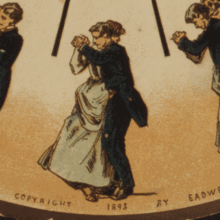Phenakistiscope

The phenakistiscope (from ancient Greek phenax "deceiver", and skopein "to look at"; literally "eye deceiver" ) was developed at the same time by the Belgian physicist Joseph Antoine Ferdinand Plateau and the Austrian professor of practical geometry Simon Stampfer in connection with experiments on stroboscopic movement in the early 1830s Years developed. As early as 1833, the first models of the phenakistiscope were brought onto the market in London as an entertainment medium. The device was also known by the name Phanakistiskop , Phantaskop , Wonder Wheel or Wheel of Life .
functionality
Drawings of movement phases are arranged in a circle on a rotating disk. There are slots between the drawings. The disc is set in rotation, the viewer looks from behind through the slits at the drawings visible in a mirror, which move for him. The impression of movement arises from the fact that the change between slit and disc presents the eye with a new image instead of the old one, which is interpreted in the brain as movement of the same image.
This is the first application of stroboscopic motion to animate drawn images ; the first calculated images were also animated with the phenakistiscope . A second important effect that occurs is the flicker fusion of the light image against the dark phase between the slits, which means that it is barely perceived and a smooth transition of the images into one another is created. The perception of movement in differing images that are shown one after the other is also called beta movement .
Independently of Plateau, other scientists such as Simon Stampfer and William George Horner , who also dealt with optical phenomena in connection with stroboscopic movement, developed similar devices, which became known as " stroboscopes " or " zoetrope ". Franz von Uchatius combined the phenakistiscope with the magic lantern in 1853 to create a projection apparatus. This invention was further developed by Charles-Émile Reynaud in 1877 with the Praxinoscope through the integration of mirrors and lighting. Eadweard Muybridge achieved further improvements in 1879 with the zoopraxiskope and Ottomar Anschütz in 1884 with the electrotachyscope , until finally Thomas Alva Edison presented the kinetograph and the kinetoscope in 1892 .
Medium for reviewing motion studies
To check the recordings of moving objects made possible in the 1870s and 1880s by sensitive photographic materials and fast camera shutters, one had to rely on the medium “phenakistiscope”. The correctness of the "seemingly impossible positions" depicted on the individual photos was often questioned and could not be verified through perception. Only the presentation of the individual images in the correct order and at the correct speed provided evidence of the scientific relevance of chronophotography .
Perceptual Physiology and Cinematography
Film historians see in the phenakistiscope “the archetypes of an evolutionary technical development, which towards the end of the century lead to a single predominant form. Above all, they are seen as the still incomplete forerunners of the film. "
The preoccupation with the "problem of the afterimage and the temporality of subjective vision" in the 19th century, which in Europe became the subject of the most diverse branches of science, is to be classified in a larger epistemological context.
Timetable
- from 1600: Flip book - flip book with individual images
- from 1671: Laterna magica - magic lantern: early device for image projection
- from 1825: Thaumatrop - miracle disc with two threads
- from 1830: Phenakistiskop - phantascope, miracle wheel or wheel of life
- from 1832: stroboscope - magic disks: flash unit
- from 1834: Zoetrop - miracle drum with slots
- from 1861: Mutoskop - stereo animation sheets per stroboscope
- from 1877: Praxinoscope - electrical high-speed viewer using a mirror arrangement
- from 1879: Zoopraxiskop - projection device for chronophotographically generated serial images
- from 1880: Kaiserpanorama - popular mass medium with stereoscopic picture series
- from 1886: Electrotachyscope - projection device for row images
- from 1891: Kinetoskop - first film viewer
Web links
Individual evidence
- ↑ Etienne-Jules Mare: Le Fusil photographique . In: La Nature. Revue des Sciences , No. 464, 1882, pp. 326-330.
- ↑ Jonathan Crary: Techniques of the Viewer: Seeing and Modernity in the 19th Century. Verlag der Kunst, Dresden / Basel 1996, ISBN 3-364-00359-9 , p. 113.
- ↑ Jonathan Crary: Techniques of the Viewer: Seeing and Modernity in the 19th Century. Verlag der Kunst, Dresden / Basel 1996, ISBN 3-364-00359-9 , p. 104 ff.
